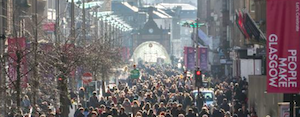The number of store closures across Scotland’s high streets has fallen to its lowest level in the last six years, but the country’s most popular shopping areas are still seeing more than five stores per week close their doors.
That’s according to the latest report by the Local Data Company for PwC.
The performance in 2018 means there has been a net loss of more than 500 stores across Scotland’s eight largest retail centres since 2013, with 1,816 closures being offset by just 1,281 openings.
The report reveals that 265 shops closed across key towns and cities in Scotland last year as the retail sector continues to grapple with the growth in online shopping and wider economic uncertainty.
In contrast, 146 new stores opened, resulting in 119 net closures, a net change rate of -3.65%.
This improvement from -4.48% in 2017 means Scotland is the only one of 11 nations and regions in Great Britain to see a drop in net closures in 2018.
However last year’s net closure number remained higher than in any other year since the data was first gathered in 2013.
Mark Addley, head of business recovery services for PwC in Scotland, said: “We may have seen a reduction in the number of stores closing across Scotland, but this is coupled with store openings at almost half the total we were seeing five years ago, so there remain enormous challenges across our high streets.
“We have already seen casualties in 2019 and we fully expect to see more, with retail companies facing an uphill battle to survive, never mind thrive.
“To be in the best possible shape to get through this, retailers must focus on ensuring they have the right proposition, and the investment required to deliver it.
“In the immediate term, retailers need full-scale solutions which sustainably cut costs and allow for new money investment to bridge the lag between the cost of a restructuring and long-term performance improvements, all while fully addressing the needs of their customers.”
Addley added: “From business failures to store closures and company voluntary arrangements (CVAs), we continue to see the impact of a high street in a state of change.
“With consumers continuing to migrate to online shopping there is a need for a societal conversation on the role of the high street and how retailers and landlords can best service this.
“The high street of the future will not be solely dependent on traditional stores.
“Across Great Britain, we are seeing a growth in the numbers’ of gyms and ice cream parlours for example.
“We need more of this new way of thinking.
“The relatively low number of openings means our high streets are becoming more blighted with empty store-fronts, so decisions will need made on what exactly a high street is for in 2019 with local authorities and landlords having to consider repurposing sites.”
